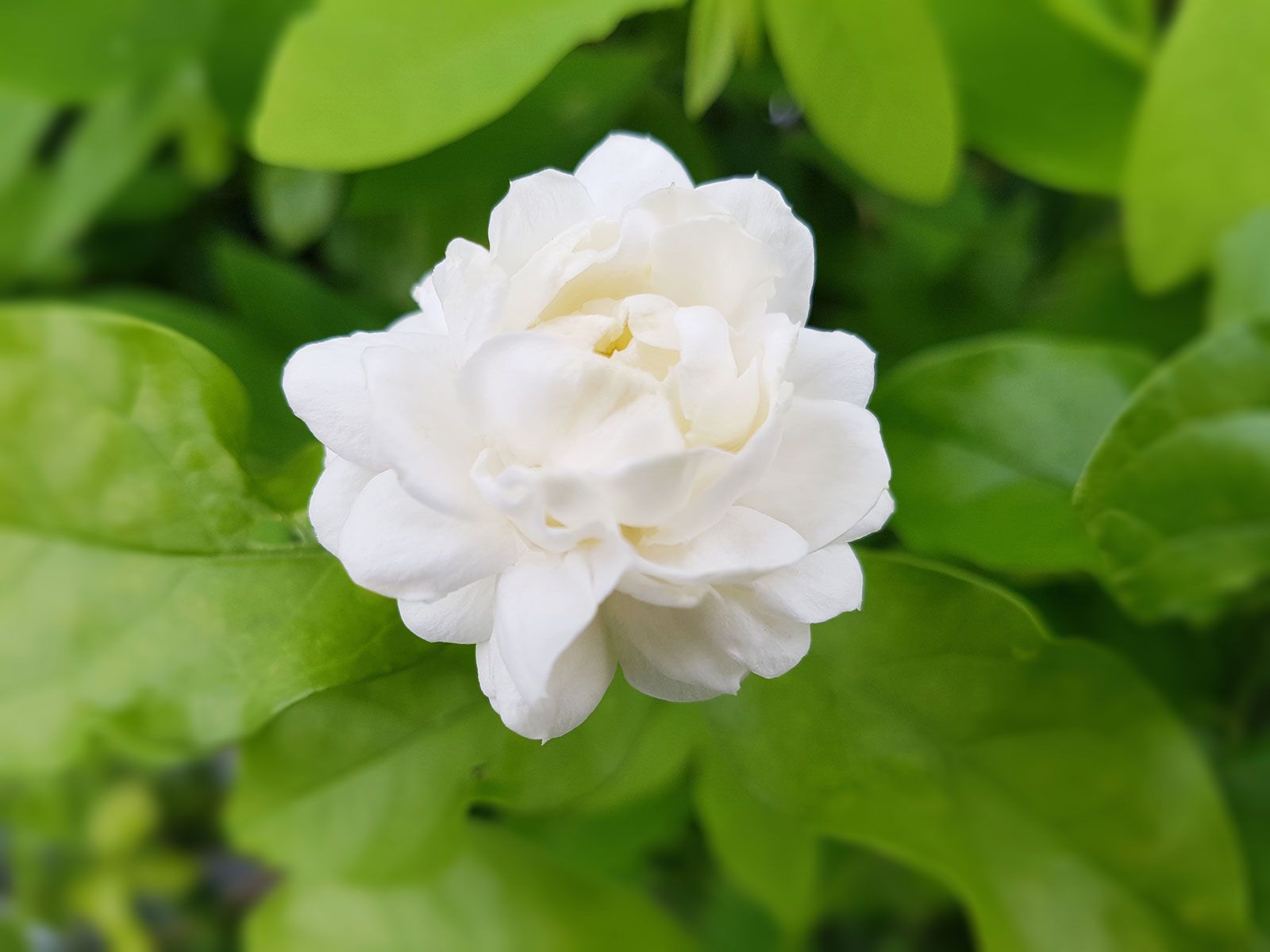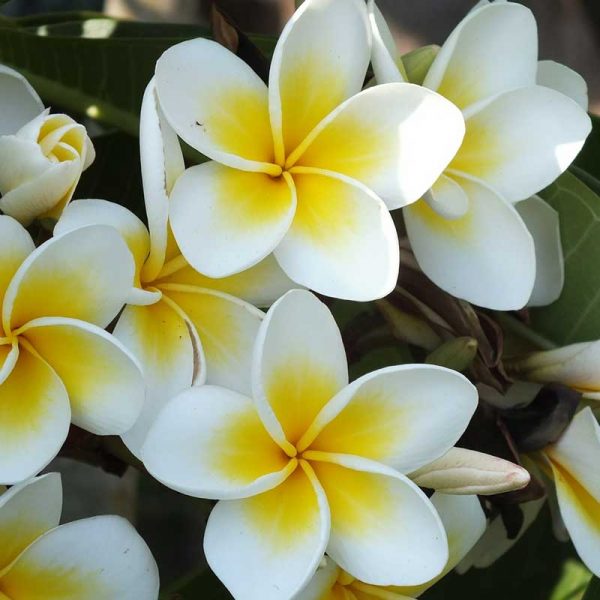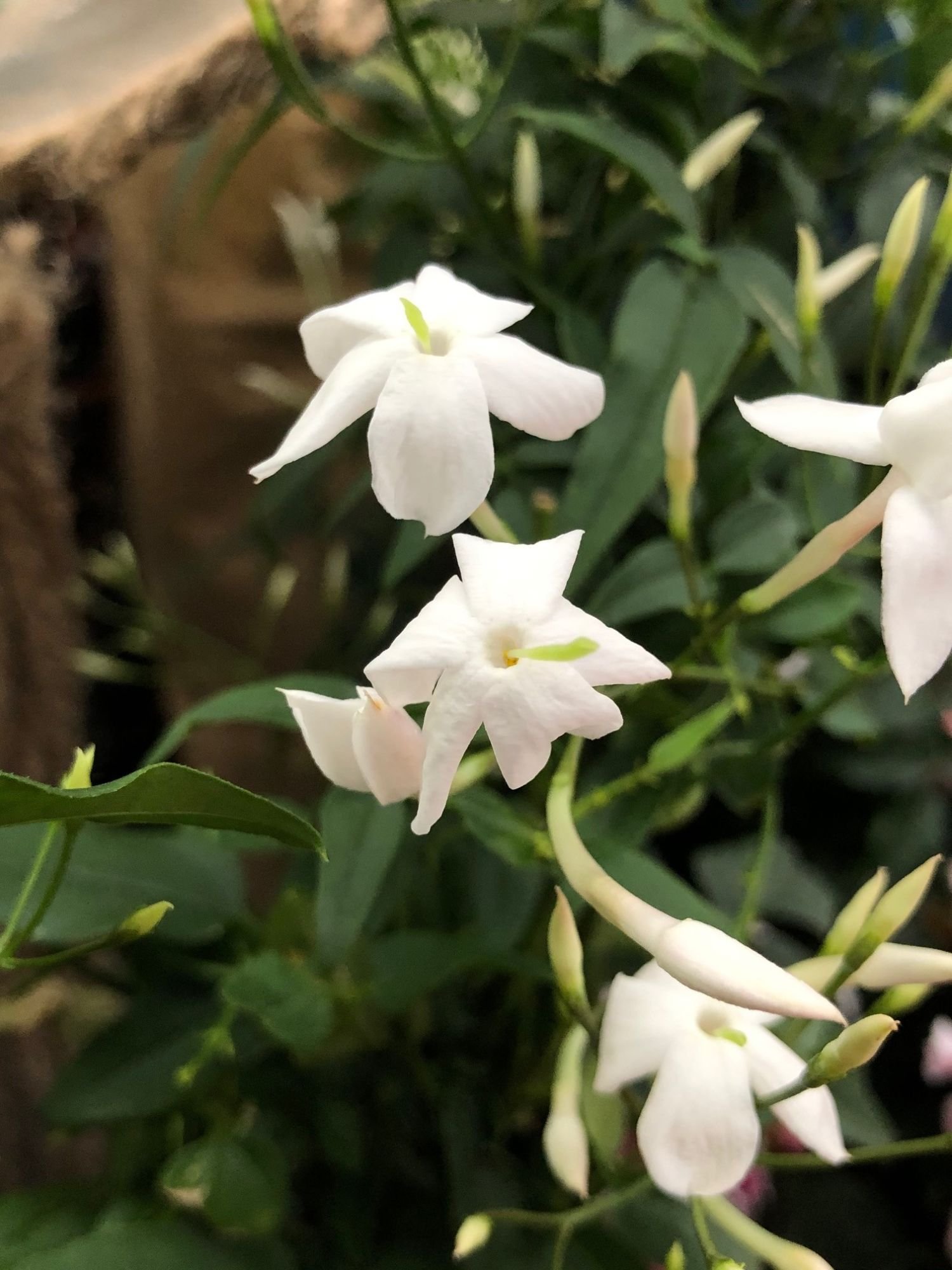
If jasmine is planted in shade, is drought-stressed, or was excessively clipped the year prior, it will not bloom. When nitrogen levels are too high, flowers may suffer. Jasmine species can bloom at various periods of the year. To prevent removing flower buds, prune in the fall.
Continue reading to learn why and how to encourage blooming if your jasmine isn’t flowering.
Table of Contents
Different Species of Jasmine Flower at Different Times
It can be puzzling if your jasmine isn’t blossoming when you expected it to because there are three primary types of jasmine that gardeners grow. Each species has a tendency to flower at different periods of the year.
- Common Jasmine (Jasminum officinale), which blooms in the early spring and can rebloom in the summer, is more vulnerable to cold temperatures.
- The more resilient Winter Jasmine (Jasminum nudiflorum) blooms from November to March.
- Due to its sensitivity to cold, the Many Flowered Jasmine (Jasminum polyanthum), which normally blooms in April or June, is more frequently planted as a house plant.
To find out what species your jasmine variety belongs to and to learn when it should bloom and whether it will survive in your climate, check the label that came with the plant.
Numerous variables affect when flowers will appear, so your plant may flower a little earlier or later than is typical for its species.
Read on to see why this might be the case if your jasmine hasn’t blossomed this entire year.
Lack of Sun Prevents Jasmine Flowering
For the finest flowering and strongest perfume, all jasmine species need full light. The Jasmine will produce fewer flowers as it receives fewer sun hours.
The jasmine plant grows naturally in full sun in tropical and subtropical Asia.
While certain jasmine varieties (like Winter Jasmine) do not need a tropical climate to grow and flower, they all require as much sunlight as possible for a profusion of flowers.
In the Spring or Summer, jasmine will bloom in 6 hours or more of direct sunlight, but the more sunlight, the better for flowering and plant health.
The jasmine may be stressed and unable to flower with fewer than six hours of direct sunlight.
If your jasmine is too shaded, move it to a sunny south-facing wall. If you’re growing it indoors, place it in the sunniest window in the house to encourage flowering.
Jasmine Not Flowering due to Drought Stress
In order to prevent excess water from pooling around the roots, jasmine prefers a combination of constantly moist soil and sufficient drainage.
In example, if there is drought in the Spring as the buds are forming, the stress might prevent jasmine from flowering if the soil around the roots completely dries out.
Jasmine with inadequate watering has poor growth, drooping or curled leaves, and fewer blossoms.
There are a few reasons why jasmine may not bloom owing to a lack of moisture, therefore underwatering is not usually the main cause of drought stress.
- strong winds Jasmines are climbers that prefer to live in protected settings, frequently against walls or fences, where they are shielded from the wind yet still enjoy a gentle breeze. Extremely strong winds can dry out jasmine plants and interfere with flowering if they are in overly exposed regions.
- dreadful sandy soils Jasmine prefers rich, organic soil that is wet (compost, leaf mold, well rotted manure etc.). If your soil is sandy, the roots of the jasmine plant may have trouble absorbing the moisture they need, leading to dryness and fewer blossoms.
- pots that quickly dry out. Jasmine thrive in containers, but if you are not careful to water them, they are more susceptible to drought stress. Jasmines prefer warm, sunny environments that can quickly dry out pots, especially if the pot is small.
It’s crucial to keep the soil continually moist if you want to resuscitate a jasmine plant that has stopped blooming due to drought stress. Improve the environment around your jasmine plant by doing the following things to make it bloom:
- To accommodate the circumstances, increase the jasmine’s watering frequency. Due to their deep roots, established jasmines frequently only need water during times of drought; however, younger jasmines and those grown in pots need more frequent watering during the spring and summer to prevent drought stress and enable flowering. During the growing season, water your jasmine thoroughly once a week to encourage root development and boost drought resistance.
- To avoid excessive moisture loss from the leaves, try to place Jasmine in a protected area or use other plants as windbreaks. To temporarily enhance humidity and counteract the effects of drought, mist spray the leaves.
- I advise spreading mulch to the soil twice a year if it drains rapidly. Compost, leaf mold, or well-rotted manure are examples of mulch that contribute nutrients to the soil, retain moisture, and strengthen the soil’s structure. To conserve moisture at the beginning of the growth season, cover the soil’s surface with a 1 inch layer of mulch in the spring. Another layer of mulch should be applied in the fall to protect the roots from freezing.
- Transferring potted jasmine under drought stress to a larger pot frequently benefits them. A larger container has a stronger ability to retain moisture since it can hold more soil. For the best potting mix that can help you save water and encourage flowering, combine multifunctional compost, leaf mold, and some well-rotted manure.
- As much sunlight as possible should be provided for indoor potted jasmine plants, but the pot should be kept away from any sources of heat or air currents, such as forced air, radiators, or air conditioning, and it should be watered more frequently.
The jasmine should start to recover from drought stress with more frequent watering, a mulch that retains moisture, and leaf spraying.
Since drought in the spring tends to interfere with flower production, whether or not it blooms truly relies on when it experiences stress.
A more hydrated Jasmine, however, might bloom later in the season or be better prepared to blossom the next year.
Water Stress Prevents Jasmine Flowering

Jasmine does not tolerate soggy soil near the roots and needs soil that is moist but drains well.
A Jasmine with too much water around the roots may have yellow, drooping leaves and fewer blooms because too much water can lead to fungus and deprive the roots of oxygen.
Because of its sensitivity to water, jasmine does not flower for a number of reasons:
- excess watering If the soil is well draining and has a good structure, it is difficult to water your jasmine too regularly so as to limit blooming, but frequent watering mixed with slow-draining soils results in water stress and stops jasmine from flowering.
- soils that drain slowly. Jasmine is more susceptible to root rot, which prevents it from flowering and causes the plant to wither, if the soils are naturally soggy or slow draining because of thick clay.
- containers and pots. It is crucial to check that the bases of pots and containers have drainage holes so that any surplus water may freely drain without being obstructed by roots or compacted soil. Your jasmine won’t flower in pots with poor drainage because water pools around the roots, which frequently results in the plant’s death.
Scale back watering as soon as you feel your jasmine is experiencing water stress.
Jasmine in pots or containers without drainage holes should be moved to appropriate pots, making sure that any extra water can drain.
It is advisable to transfer jasmine that has been planted in soggy garden soil because the plant will likely die from root rot and damp dirt.
Move the jasmine to a part of the garden with well-prepared soil and heaps of compost amendment to strengthen the soil.
Consider removing the Jasmine root ball out of the ground and placing it in a pot if moving your Jasmine is less practical (because it is fixed to a wall or fence).
Instead of improving naturally marshy soil, it is far simpler to improve soil in pots or containers so that Jasmine can grow and bloom.
Give your jasmine a chance to recover so it can survive and possibly produce blossoms by letting the top two inches of the soil dry out before watering it once again.
Too Much Fertilizer can Stop Jasmine Flowering
Jasmine thrives in nutrient-rich soil and can flourish during the growth and flowering stages with a sparing application of fertilizer.
If you apply fertilizer too frequently or in too high a concentration, especially fertilizer with a high concentration of nitrogen, jasmine does not flower as effectively.
Although nitrogen is necessary for the growth of foliage, too much of it can favor foliage at the price of flowers.
You are probably overfeeding your jasmine if it is vigorous, green, and has a lot of foliage but no flowers.
Reduce the amount of fertilizer you use, and give your Jasmine regular waterings to help remove extra water-soluble nutrients.
It may be challenging to encourage flowering this season if the jasmine lacks blossoms as a result of excessive fertilizer, but it should recover and be able to bloom the next year.
I advise using a slow release granular fertilizer instead of liquid fertilizers to avoid difficulties caused by an excess of nitrogen in a short period of time. These fertilizers release nutrients at a slower rate and at the proper concentration.
All the nutrients that jasmine needs are present in the proper concentration in a balanced all-purpose granular fertilizer like miracle-gro.
Nutrient Poor Soil Prevents Jasmine Flowering
The leaves of jasmine tend to turn yellow and produce fewer blossoms in sandy, nutrient-poor soil.
Jasmine is also a climber that is frequently grown up a wall.
Because the foundations of the wall may prevent normal root growth, nutrient-rich soil is crucial for Jasmine to flower.
To achieve the best soil structure, moisture holding capacity, and nutritional content, the soil should ideally be supplemented with substances like compost, leaf mold, and well-rotted manure.
Mulch applications, however, can boost the soil’s fertility for established jasmine plants.
Again, the ideal mulch materials to add nutrients and to stimulate the soil ecosystem, which enhances the availability of nutrients at the roots of plants, are compost, leaf mold, and well-rotted manure.
Apply a 1-inch layer of mulch to the soil’s surface, being careful to keep it away from the jasmine’s stem to prevent rot.
As previously mentioned, I advise using a slow-release, all-purpose fertilizer on jasmine to avoid difficulties with flowering due to an excess of nitrogen.
To give nutrients and encourage flower growth, granular fertilizer only has to be applied twice a year—once in the spring and once in the summer.
If the soil is sandy and does not hold nutrients, fertilizer becomes more crucial.
Because of a lack of nutrients in the soil, jasmine plants grown in pots and containers may also stop blooming.
The roots of Jasmine may deplete the nutrients in the pot if it has been in the same place for a long period.
Repotting the Jasmine in a bigger container with fresh soil is the answer at that point. Because a larger pot has more soil capacity, the roots have easier access to nutrients.
To give the jasmine the nutrition it needs to bloom, use a high-quality multipurpose compost that has been treated with leaf mold and manure.
When jasmine is grown in pots, fertilizer needs to be applied more frequently. To boost flowers and plant health from the spring through the middle of the summer, apply a liquid fertilizer that is half strength and properly balanced once every month.
Pruning Jasmine at the Wrong Time Can Remove Flower Buds

Jasmine should not be pruned in the spring or summer as you risk removing the growth on which the flowers are forming and preventing flowering.
After flowering, jasmine plants benefit from a light pruning in the fall with the aim of cleaning up any unruly growth and untangling any vines.
As the jasmine focuses its energy to growing back the foliage before it can flower, a harsh prune can halt the flowering for several years.
The jasmine is more likely to bloom the next year when its new growth has grown if you trimmed it back severely or at the wrong time of year.
Key Takeaways:
- Jasmine typically doesn’t bloom due of soil that has too much nitrogen, drought stress, or improper pruning timing. Jasmine can be pruned back in the spring or summer to get rid of the growth where the flowers grow.
- Check the label to find out when your particular variety should bloom because different jasmine species bloom at various times of the year.
- In the Spring and Summer, jasmine needs constantly moist soil; if the soil dries out or becomes flooded, the plant may have trouble flowering.
- Too much fertilizer may encourage the growth of foliage at the price of flowering. Jasmine should be planted in fertile soil and fertilized in the spring and summer.
